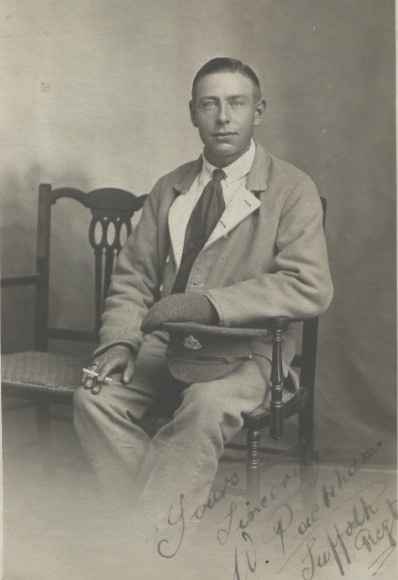By David Rowe
Gladys was the daughter of Philip Arthur Lloyd and Elizabeth Jones. The 1902 Advert describes her father’s business. ‘ARTHUR LLOYD JONES, GWALIA HOUSE Tea, Coffee and Refreshment Rooms, 61 High Street, MOLD. refreshments at moderate prices.’

Mr & Mrs Arthur Lloyd Jones, Gladys and a maid. During World War I, Gladys, then 15 years old was employed as a maid at Leeswood Hall Auxiliary Military Hospital. The owner, Violet Wynne-Eyton, turned the hall over to Army and she went to live elsewhere. The patients at these auxilliary hospitals were generally less seriously wounded than at other hospitals and generally needed to convalesce. The servicemen preferred the auxiliary hospitals to military hospitals because they were not so strict, they were less crowded and the surroundings were more homely. In the of county Flintshire, hospitals would be found in the following locations:
Talardy, Auxiliary Hospital, St. Asaph.
Leeswood Hall, Auxiliary Hospital, Mold.
Rhyl and District Auxiliary Hospital Rhyl.
Pentrefyon Convalescent Home, Holywell.
These hospitals were manned by ‘voluntary aided detachments’ (VAD’s), and over 90,000 people volunteered for the British Red Cross during the First World War. Mold was no exception and many people volunteered to work at Leeswood Hall. Among the professional medical staff was local GP, Dr. Roger Edwards, and who later was awarded the M.B.E. for services to the hospital.

Patients and staff outside Leeswood Hall
As was the normal practice many children and young people kept autograph books/albums and Gladys was no exception. These tended to have entries from family, friends and schoolteachers, and often were accompanied by a sketch, pressed flower or other ephemera. However, what makes Gladys’s album special is that contained entries by patients at Leeswood Hall Auxiliary Hospital. Below is the front page of the album showing her address as Gwalia House, Mold

This entry by Mary Dunn is an excellent example of the sketches and cartoons contained within the album.
The next contributor, E.H. Evans, has combined a traditional ‘wish’ with a flower background.
The pencil sketch of what appears to be the Phoenix Tower on Chester City Walls was drawn on the 8th January, 1928 by A or H. Morris
As a complete contrast this embroidered flower was made by Amy Roberts of Caerwys.
Religious texts commonly appear in autograph albums and this one written by the Scottish poet J. Ballantyne (1806-1877), was entered ten in the book by a patient at Leeswood Hall, Corporal R. W. Blanckley on June 18th, 1917. No regiment is listed, but can we assume he was Scottish?

The next entry is another cartoon depicting a sailor serving on H.M.S. Spitfire, with a rather cynical quote at the bottom of the page. The Tyne built HMS Spitfire was an Acasta-class destroyer of the Royal Navy. H.M.S. Spitfire took part in the battle of Jutland in 1916, where it collided with the German battleship, Nassau. Although both were badly damaged they managed to return to their respective home ports where they were repaired. Why a soldier of the Suffolk Regiment should choose to draw a Royal Navy sailor we will probably never know. Corporal W. Packham of the 7th Battalion, The Suffolk Regiment was wounded at the River Scarpe, Arras during one of the three Battles of Scarpe. The three battles were as follows: 1st. 9th-14th April, 1917; 2nd. 23Rd – 24th April;3rd. -4th May. In his 3rd June 1917 entry, Cpl. Packham refers to being wounded on April 28th, thereby falling between battles 2 and 3 and indicating that fire was still being exchanged. The nature of his wound is not known but with him being cared for at Leeswood would suggest it was not life threatening or changing. The 7th Battalion was raised at Bury St. Edmunds, as part of Kitchener’s Army, in 1914 and was absorbed into the Cambridgeshire Regiment in 1918. It reformed in 1940, before being absorbed into the 142 Regiment Royal Armoured Corps and was finally disbanded in 1945.
The Great War Website members have been extremely helpful in attempting to identify Packham and the other soldiers who have written in the album. One option is Corporal 9372 W. Packham, who was wounded while serving with the Expeditionary Force and admitted to Lord Derby War Hospital, Warrington on the 3rd May 1917. He was renumbered 308168 and transferred to the Tank Corps. A coincidence or is this our artist?
Considering the high rate of casualties and deaths during the first two and a bit years of the war, it is surprising to find that the then deceased Lord Kitchener still attracted respect from the ranks. In 1914, Earl Kitchener was appointed Secretary of State for War, a position he held until June 1916. When on board H.M.S. Hampshire travelling to Russia, the ship struck a German mine and Kitchener was one of the 737 who died.

Corporal Smoker? who signed the book on 2nd June 1917, unfortunately did not include details of his Regiment or any other information, so he remains another anonymous soldier.
Returning to the more mundane. Entries like this alphabetical one from D.Evans, gave suggestions on life styles and the virtues required by a lady. No doubt written by a man!
There was often the quirky entry and F.W. Odgers from New Mexico, U.S.A. decided to write his entry upside down. For ease of the reader I have replicated this the correct way up.
Diaries often contained words of wisdom from parents. Gladys’s father was no exception.
Words of wisdom were not restricted to parents and the following by Melton E. Jones highlight what many girls were expected to hanker after.
Another wonderful pictorial entry by M.H. of Manchester, although we don’t know whether the contributor was a relative, friend or hospital patient.
The pencil sketch of 17th June, 1917 was inserted by G. Mitchell of the 20th Battalion (Tyneside Scottish) of the Northumberland Fusiliers.
The 20th (1st Tyneside Scottish) was raised by the Lord Mayor & City in Newcastle in 1914. Considered a ‘Pals’ Battalion they consisted mainly of men of Scottish descent. Like R.W. Blanckley, G. Mitchell served during the battles for Scarpe and perhaps they were both wounded around the same time, hence both ending up at Leeswood. Many of the Northumberland Fusiliers for whom there is no known grave are commemorated on the Thiepval Memorial. The Great War Website has identified two possible soldiers, firstly George Mitchell 39569,. Was he among the 200 plus of the Battalion wounded on the 9th April 1917. The second is Fusilier George Mitchell, 48347 who subsequently was transferred to the Labour Corps 547129. Pension records indicate that he was born in 1896 and lived in in Leeds with his wife and one child. If this is our man he was discharged from the Army with Acute Rheumatism and Valvular Disorder (Disease of Heart) and was initially awarded a pension of 8s 3d (41p) per week.
H. S. Shaw showed his skill with this watercolour inserted in June 1913
The next two entries offer life advice and are illustrated by excellent drawings. They both appear to have been entered by local people, J.Gwen Davies and J.H. Jones. The initials A.C.S are a little bit of mystery.


The third one in the sequence entered by H. Bennett of Bridge House, and offers more life advice. Is this the house at Rhyd Y Goleu next to Synthite?
The happy dog and cat entered on the 5th April 1913 by M. Blodwen Morris of Laurel House, Pontblyddyn, was possibly premature. According to the Flintshire War Memorials, an Arthur Evan Morris of Laurel House, a school teacher, was killed in action on the 15th February 1917 while serving with the 8th Battalion Royal Welsh Fusiliers. My thanks to Vivien Williams of Flintshire War Memorials for the following additional information. The 1911 census lists the Morris family living at Laurel House, including Arthur’s 17 year old sister who is described as being at school. Marian Blodwen Morris never married and continued to live at The Laurels until her death in Chester City Hospital in 1965. Blodwen is buried in Pontblyddyn churchyard, the grave she shares with Margaret Gwendoline Morris, is marked with a headstone.
The next entry from M.G. Jones refers to their claim to be the finest friend.
The next six entries are from local people although Llewelyn W. Price appears to have emigrated to Manitoba, Canada



The next entry is by Private C. South of the South Lancashire Regiment, but as he doesn’t specify a Battalion it’s not possible to identify him or where he was wounded. During the Great War the 21 Battalions of the South Lancs. served on the Western Front, Gallipoli, Macedonia, Egypt, Mesopotamia (Iraq), and India. The Regiment suffered 5,450 casualties, including a number from the 11th Battalion of the South Lancs., at the Battle of Scarpe (Arras) which commenced on the 9th April 1917. As the entry in the album is dated 31st May, 1917 could this have been hisbattalion? Also a pattern is developing here, in that some of the previous patients are linked to this particular location. Have they travelled in the same evacuation and found themselves together at Leeswood Hall? Unfortunately it is unlikely we will find the truth.

One of the other Regiments at Arras was the Argyll and Sutherland Highlanders and Private A.D. Imper of the 6th Battalion, recorded in the album that he was wounded on the 23rd April 1917. Another one wounded in this action so consolidating the argument regarding soldiers wounded in the same engagement.
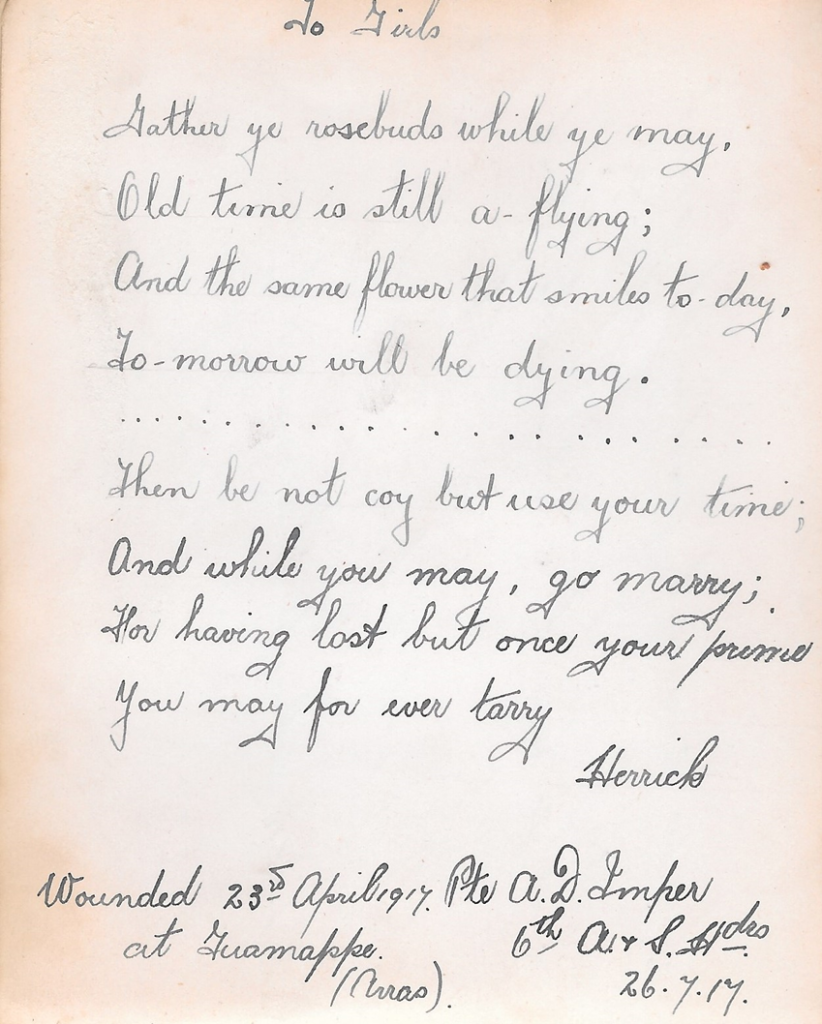
One of the other Regiments at Arras was the Argyll and Sutherland
Highlanders and Private A.D. Imper of the 6th Battalion, recorded in the album that he was wounded on the 23rd April 1917. Another one wounded in this action so consolidating the argument regarding soldiers wounded in the same engagement.
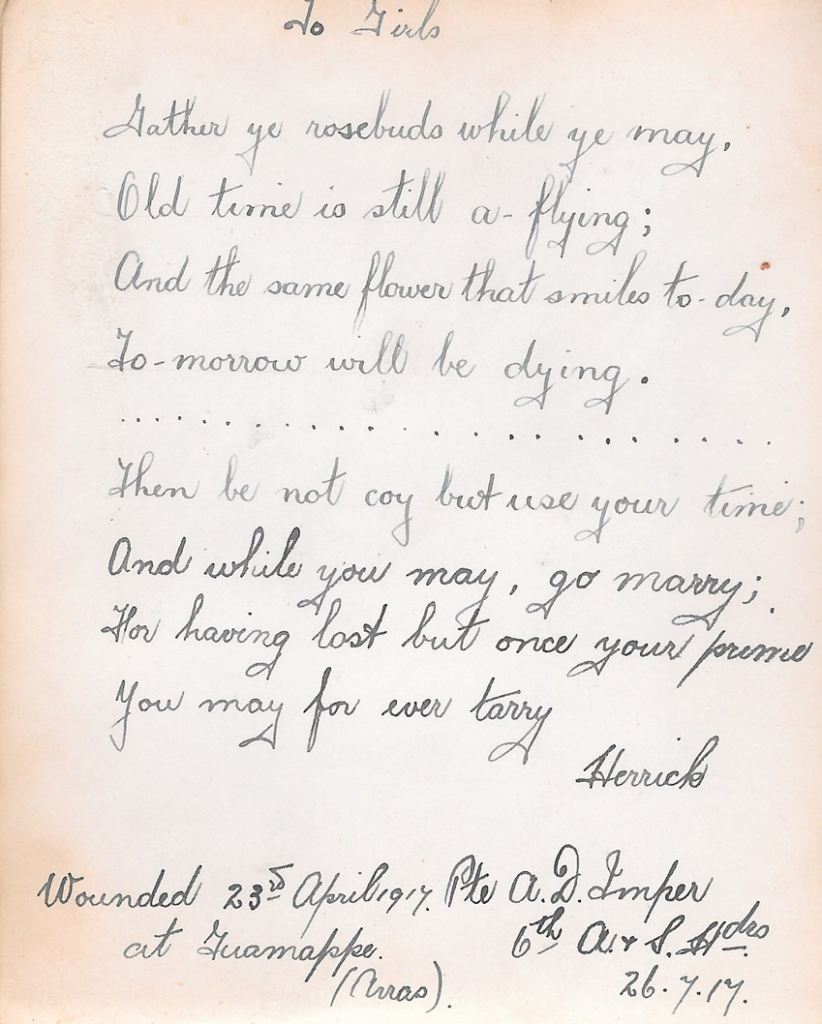
The following entry is somewhat strange in that the patient’s entry refers to the sinking of the Empress of Ireland in May 1914.
This resulted in the deaths of 840 passengers out of a total of 1057. The sinking was the result of a collision between the Empress and a Norwegian
collier, so not related to the war.
Private A. Kirk of the Machine Gun Corps late of 7 th King’s (Liverpool) Regiment which is also listed as the 7 th (Isle of Man) Volunteer Battalion.
so is our soldier of Irish descent? The Machine Gun Corps (MGC) was a Corps of the British Army, formed in October 1915. This in response to the need for more effective use of machine guns on the Western Front during the First World War. After a year of warfare on the Western Front some commanders advocated crewing them with specially trained men, who were not only thoroughly conversant with their weapons but understood how they should be best deployed for maximum effect.
To achieve this, the Machine Gun Corps was formed in October 1915. The Infantry Branch was by far the largest and was formed by the transfer of battalion machine gun sections to the MGC. These sections were grouped into Brigade Machine Gun Companies, three per division and a specialist officer was added to each brigade headquarters to coordinate their use New companies were raised at Grantham. In 1917, a fourth company was added to each division. In February and March 1918, the four companies in each division were formed into a Machine Gun Battalion. The Infantry Branch was dependent on horse drawn transport. Each section of four guns required two wagons for the guns and a third for 32,000 rounds of ammunition.

Another one of the patients who was wounded in Arras during April 1917, is Private Walter Cook of the 1 st Battalion Border Regiment.
His entry reflects the attitude of many servicemen who felt that they were following the call of duty to King and country. The Regimental Headquarters were based in Carlisle Castle, with the lively ‘John Peel’ as the regimental march.
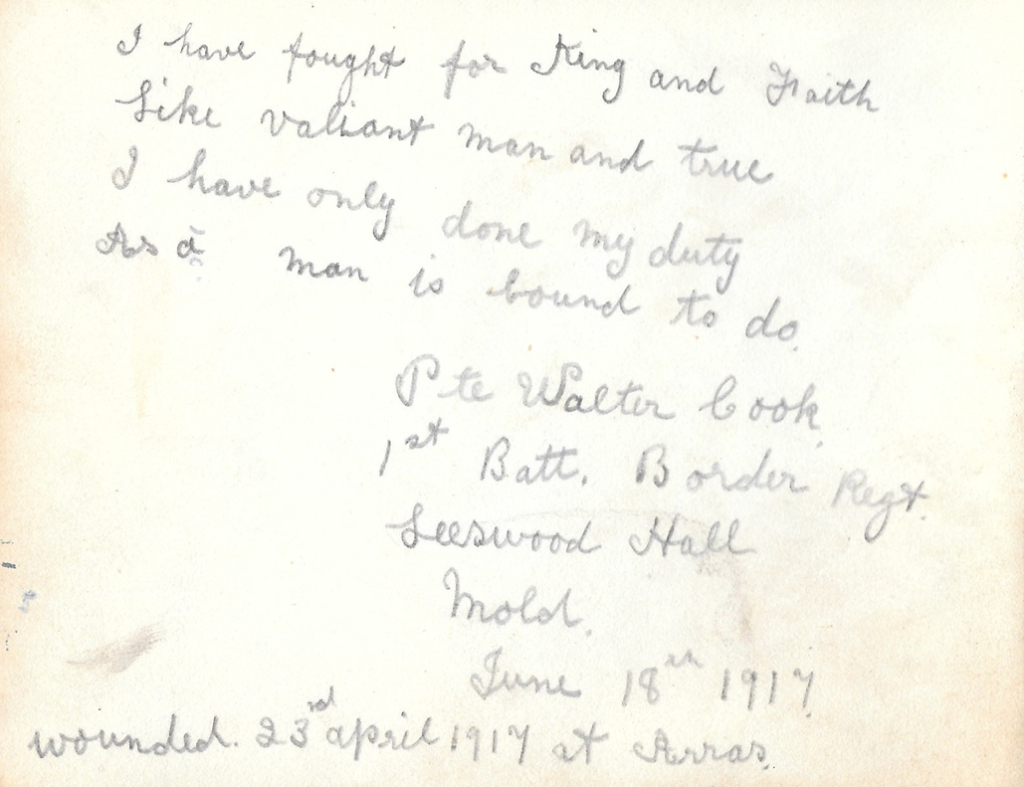
Back to local entries with a humorous drawing of a dachshund by R.E. Price of ‘Tirionfa’, Pen-y-ffordd Avenue, Mold. (now Ruthin Road)

Another undated entry with pearls of wisdom written by Sally Jones of Black Brook, Mold.
A school friend, Eve, wrote an unusual dedication in 1913, starting with a two line statement.
“In the chimney of your memory
consider me a brick.”
Sergeant Sherret, a patient at Leeswood Hall, unfortunately did not give details of his regiment, but looking at the date perhaps he is another one of the Scarpe engagement?
The good Sergeant Sherret had two entries and the following cartoon is clearly intended to represent the Kaiser.
No name and intended to confuse the reader.
Two entries on the one page from different people, with both offering life advice to a young girl.
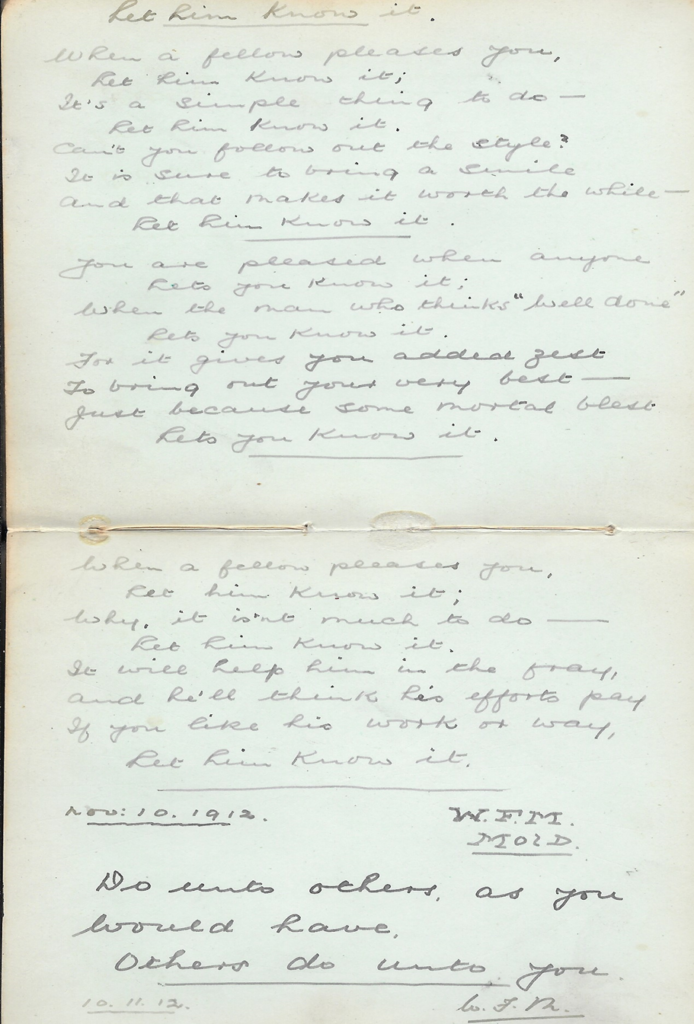
The surname of Mabel G.L unfortunately is not legible, but is clearly from a friend living at Tyn y Capel. Is this the Inn in Minera, or was there a building in the vicinity of Mold that shared this name?
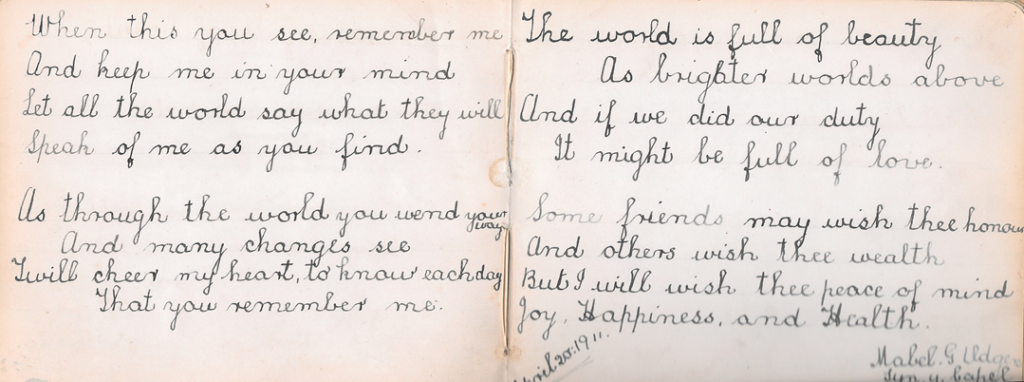
J.G.H. was responsible for this sketch in 1914 and we can only assume that this is of Gladys.
The theme of the sketch by H. Morris on the 10th January 1920, would suggest that the artist is a serving or an ex-serviceman with its ‘trench humour.’

Headlined ‘Situation Shortly Vacant,’ it shows a shell en-route to its target with the following statement. “In an old fashioned house in France an opening will shortly occur for a young man, with good prospects of getting a rise.”
A very strange cartoon drawn by Willie Jones of Welsby Villa, Pantymwyn, which is probably meant to carry the message, “If you don’t succeed the first time try, try again.”
Welsby Villa, Pantymwyn was at one time the home of the internationally renowned artist Augustus Osborne Lamplough (1877-1930).
The two autograph albums contained other entries not included in this paper, and before we look at what happened to Gladys post-war, the family suffered two tragedies as reported in newspapers.
Firstly, her father one night was awakened by the smell of fire, and found his premises on fire. He and his family were trapped upstairs, and took refuge on the balcony over the shop, being rescued by ladders as the flames were almost licking their backs. Sadly a maid residing in the house, however, perished in the fire. Secondly, the Cheshire Observer of the 20th January carried the following story. “ROAD FATALITY AT MOLD An elderly native of Mold met with a tragic end on Thursday night. Mr. Arthur Lloyd Jones, aged 75, a retired confectioner, late of Gwalia House, High Street, who resided at the Lead Mills, was crossing the main road, near the Bridge Inn, to enjoy his customary chat with a friend residing in the vicinity, when he was knocked down and fatally injured by a milk lorry. Mr. Jones spent the whole of his life in Mold and was a property owner. He was the younger son of the late Mr. and Mrs. Joseph Jones, bakers, High-street, and was a widower. He is survived by three daughters, one of whom is the wife of Police Sergeant E. G. Hughes, Caerwys.” The Sunderland Daily Echo and Shipping Gazette commented that at the time of the accident he was wearing his slippers.
So what of Gladys?
In 1927, Gladys met John (Jock) White, the owner of a butchers shop in Shettleston on the outskirts of Glasgow.

Shettleston on the outskirts of Glasgow.
The subsequently married and are pictured on their honeymoon.
Their only child was Betty, and she is pictured with her parents on the occasion of her 21st Birthday.
In a strange twist of fate, Gladys came down from Glasgow with her baby daughter, Betty, to visit family in Mold, but without a pram. As she knew Mrs Williams, who had a son called Eryl, the two young children shared a pram.
In April 1958, Eryl & Betty were married and their family was complete with two children. Eryl went onto become Assistant County Treasurer and was well known locally. He carried out the annual audits for a number of community organisations, including Mold Cricket Club and Tyddyn Street Church. I had the pleasure of counting Eryl among my friends. My thanks go to his daughter Fiona Woolfall for loan of the album, information and photographs.
David Rowe 23rd July 2023
Copyright of articles
lies with the Mold Civic Society and individual contributors.
Contents and opinions expressed therein
remains the responsibility of individual authors.





